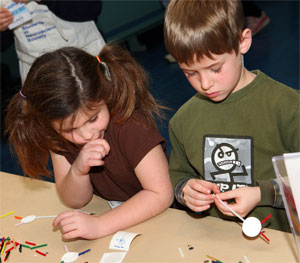| ||
|
āItās squishy, squirmy,ā he declares as his finger makes the brain jiggle. Made of peach-flavored Jello, condensed milk and food colouring, the brain looks like cheese macaroni thatās been left at the back of the stove for a few days. The boy then knocks on his own brain: one, two, three.Ģż āItās a good thing weāve got our skulls.ā
āYes,ā agrees Amanda Green, a Dalhousie PhD student. She gives theĢżwobbly brain a poke, too. āItās soft and pliant, isnāt it? We need our hard skulls to protect our brains.ā
Ģż |
Ģż |
How hibernating creatures induce and survive in a near-death state ā known as torpor ā has long fascinated scientists. In particular, researchers looking at ways of treating strokes in humans are interested in how the brains ofĢżthese animals endure the rigors of hibernation without, as masterās student Michelle Black puts it, āturning into mush.ā
|
Strokes produce waves of brain cell destruction. The halting of the blood flow stems the brain's supply of oxygen and glucose, immediately slaying a core group of cells. Even after blood flow resumes, additional groups of nearby cells continue to succumb to the stressful event.
Kids get into grey matter: fascinated by whatĢżbrains look like and how they work. At the museum, they can take apart a plastic model of a brain to see whatās inside. And they get to do a brainy craft: making neurons of round stickers (the cell body) and pipe cleaners, which pose as dendrites and axons. The grey matter of the human brain is comprised of billions of these neurons, the cells that send and receive electro-chemical signals to and from the brain and nervous system.
āItās good to able to explain things in language children can understand. It makes us remember what got us so excited about neuroscience in the first place,ā says Ms. Mashoodh, 23, who was taken aback when a six-year-old boy asked her, āThe cells in the brainā¦ what do they have to do with deoxy-ribonucleic acid?ā
āThatās DNA to you and me,ā she adds in an aside.
Ms. Black says it was a second-year class, Introduction to Neuroscience () that had her intrigued by this field of study.
āWhen I realized our thoughts had a physical space in the brain, I was hooked. I think thatās the coolest thing ever,ā says Ms. Black, 34, a sleep researcher. āFrom day-one, I thought it was super interesting.ā


